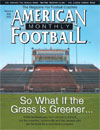AMERICAN FOOTBALL MONTHLY THE #1 RESOURCE FOR FOOTBALL COACHES
Article CategoriesAFM Magazine
|
Big-Time BoostersWell-run, well-attended booster clubs make a huge difference for some football programs.by: Scott Kraft © More from this issue Maximize Your Booster Club - Tips to excite your boosters about fundraising, helping your program succeed. Innovative Fundraising Ideas - Here are some fundraising ideas your booster club can consider to raise anywhere from a little to a lot of money to support the football program. The football boosters at Hoover High School in Birmingham, Ala., bring in over $300,000 for the program every year, part of the over $800,000 raised for athletic programs at the school. Rush Propst, the school’s ....The full article can only be seen by subscribers.
|
|
|||||||
| HOME |
MAGAZINE |
SUBSCRIBE | ONLINE COLUMNISTS | COACHING VIDEOS |
Copyright 2025, AmericanFootballMonthly.com
All Rights Reserved





